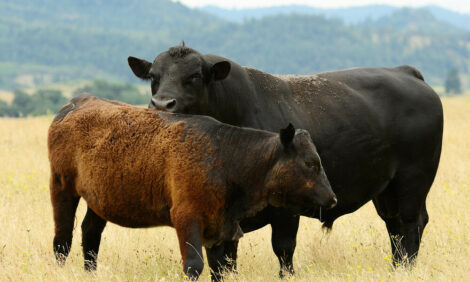



Consider Pregnancy Checking Cattle Early
US - Culling nonpregnant cows before winter feeding can result in significant savings, says Carl Dahlen, North Dakota State University Extension Service beef cattle specialist.Although winter feed costs represent 60 to 70 per cent of the expense of maintaining a beef cow, less than 20 per cent of US beef producers perform a pregnancy check in their herds.
“Producers can realise significant savings by identifying and culling nonpregnant females prior to winter feeding,” says Mr Dahlen.
Historical cull-cow markets reach a low point in November, which coincides with the time most producers would wean calves and pregnancy check cows. Based on the average cull-cow market price for 2005 to 2010, the price difference between selling in August or November is roughly eight dollar per hundredweight, which equates to a difference of $108 when selling a 1,350-pound cow.
“Producers who are able to perform pregnancy exams and subsequently cull open cows during the next several months may realize substantial financial benefits, compared with marketing cull cows in November,” Mr Dahlen says.
However, not all producers have breeding seasons, facilities and the labor force to do pregnancy exams during the late summer. Herds with defined breeding seasons are best suited to take advantage of early pregnancy exams, according to Mr Dahlen.
If bulls are run continuously with a cow herd or are being pulled from the pasture the same day as the pregnancy exam, producers have no way to determine the cows’ true pregnancy status. Cows that become pregnant early in the breeding season will be identified easily in these instances, whereas cows that appear to be “open” actually may have been bred recently. These recently bred cows may be carrying an early pregnancy that is too young to feel via rectal palpation or visualise with ultrasound.
To accurately and efficiently conduct pregnancy exams on large groups of cows, the exams should be performed from 26 to 30 days after the last possible breeding if using ultrasound for pregnancy diagnosis. If using rectal palpation, pregnancy exams should be conducted 35 to 40 days after the cows are bred.
For example, herds calving in mid to late January would have a bull turnout or artificial insemination date around 15 April. If the producer is using a 45-day breeding season, this herd would be ready to pregnancy check with ultrasound around 29 June and with palpation per rectum on 9 July. However, a herd that calves toward the end of April (July turnout) and has an 85-day breeding season will not be ready to pregnancy check until the first or second week in November.
Thus, producers with herds that calve in January through March or even late April and have a short breeding season can take advantage of early pregnancy checking to market cull cows prior to the historic market downturn of November.
“Following these guidelines, with proficient expertise, pregnancy detection should be very close to 100 percent accurate,” Mr Dahlen says. “All cows that are nonpregnant should be identified at the time of the exam.”
However, a small portion of cows determined to be pregnant during an early pregnancy exam will have fetal loss naturally prior to calving (the majority of this loss occurs by 60 days post-breeding). This fetal loss occurs whether or not producers choose to perform early pregnancy checking.
Mr Dahlen also has this advice:
- In herds with thin cows, limited pasture or limited forage, removing open cows early may allow the remaining pregnant cows more access to feed resources.
- Sufficient labor to gather and work cattle and good handling facilities make pregnancy determination less stressful on both the cattle and the people working them.
- As with all activity involving cattle during summer months, be mindful of weather conditions and avoid working cattle in extreme heat.
“Some producers can take advantage of market conditions to capitalize on the benefits of early pregnancy detection,” he says. “Others, however, will have to decide whether to pregnancy check in November or wait until spring to market open cows.”
TheCattleSite News Desk

